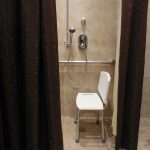This travel guide to subways in New York will help you to prepare and create a plan to get around the city when using a wheelchair.
Subway Map
The first thing you want to do is find a subway map (or skip to the trip planner). This page has up-to-date versions of the map including this one which clearly labels all the accessible stations. All versions do have the small wheelchair label next to accessible stations. There is also this webpage that has a list of all accessible stations and if you go down to “Full Station List” it will tell you the cross street and corner where each elevator is located and any pertinent information about which line/direction the elevators go to and transfers.
Subway Station Elevator Status
This is very important! Before you leave you should check to make sure the elevators you need to use are working. This page has the status of elevators and escalators on the Subway, Long Island Rail Road (LIRR), and the Metro-North Railroad (MNR). Elevator status can change at any moment so if possible check the elevator status again before you make the trip back to wherever you were coming from. Just because the elevators worked on your way there does not mean they’ll still be working on your way back.
Trip Planner
The trip planner is linked here. It works like most map apps where you put in your start and end destination and it tells you the different routes to get there using public transportation. The great thing about the MTA trip planner is it has up-to-date information on which subway lines are running and which stations have functioning elevators! So make sure to check the box for Accessible Trip and hopefully there will be reasonable options available.
** Keep in mind most stations have multiple elevators to get from street level to the platform you need to be on. In my station, I have to take 3 elevators to get to street level from the E train. So it’s important to factor in the time to wait on multiple elevators.**
Automatic Gates to Subway Stations
All accessible stations should have at least one Autogate. The Autogate has a place to insert your MetroCard or use OMNY and once it accepts your payment the gate will automatically open. If there isn’t one you can go to the booth and ask the MTA employee to open the gate for you. Normally they watch you swipe at a turnstile to show you’ve paid and then press a button in their booth that will automatically open the gate. Here is a video by the MTA demonstrating how to use the Autogate, and here is the same video with audio descriptions.
Fare
The standard fare is currently $2.75 for the subway. There is a Reduced-Fare Metrocard for people 65+ or people with qualifying disabilities. You don’t need to be an NYC resident for reduced fare MetroCards but the process takes a long time (I believe several months) so if you want or need one for a trip make sure to apply as far in advance as you can. You can apply online, by mail, or in person. The reduced fare is half price ($1.35) and you can refill reduced fare MetroCards at any machine that refills MetroCards.
According to this page on the MTA’s website, Autogate does not accept Single-Ride paper tickets. So if you are trying to use a single-ride paper ticket, I would go to the booth and tell them you are going to swipe at a turnstile and ask them to open the gate.
Seating and Spaces
There are spaces on specific subway cars that have the seats cleared and are marked for wheelchair users. Now this is just from personal experience living in NYC using a mobility aid but this is what I have found:
Many stations, particularly newer ones, have blue signs to indicate “wheelchair boarding”. I will say that I have gone to those signs several times only to find the subway cars that pulled up to that spot did not have wheelchair spaces.
Every train I’ve been on has had at least one wheelchair space on each end of the train and one or two in the middle next to the conductor. Probably the best option is to go to the middle of the platform and look for the zebra board (sometimes the “Wheelchair Boarding Area” signs are right next to the zebra board which is great!)
It is a bar that generally hangs from above on the edge of the platform, parallel to the tracks, and it has black and white stripes (sometimes the stripes only face the tracks). It can look different at different stations but it’s always there and it’s always in the middle so keep an eye out for it. It is where the conductor pulls up to on the platform. Every conductor has to stop the train when the conductor is lined up with the zebra board every time they stop at every single station. Now I don’t know if every subway line has wheelchair spaces in the cars on both sides of the conductor but so far every one I have used has had them.
The zebra board is the best option for a few reasons. 1) The conductor can keep the doors open and give you enough time to board. 2) Wheelchair spaces are almost always directly on either side of the conductor. 3) If you have any questions you can ask the conductor.
Going to the very front or end of the train is great if the subway is crowded because there are fewer people on the end of the train (though conductors are supposed to ask people not to move out of the space if they’re not using a mobility aid). The problem is that the elevators can be much farther away than if you were coming from the middle of the train and there is not always a conductor on the ends that can hold the doors or offer any other sort of help.
Exiting the Subway Station
You can exit through the Autogate. Now it is free to exit and it really irritates me but instead of having a simple button to automatically open the gate it makes you swipe your MetroCard or use OMNY. I repeat, it should not charge you for exiting even though you have to use OMNY or your MetroCard. As I have learned it will not let you out if you try to use an expired MetroCard. I haven’t tried one that has no money on it but it should be able to work because it is free to exit. If there is no Autogate you have to get the attention of the person in the booth and ask them to open the gate. I don’t think a station is considered accessible if it doesn’t have an Autogate or a booth because there is no other way to get out on your own.
Asking for Help
If you are stuck in a station because of a broken gate or elevator, you can call the fire department and they will send people to carry you and your mobility aid up the stairs. This is obviously a last resort kind of option but it is an option if you need it. To reach the fire department for emergencies call 911 and for non-emergency services call 311.
I would always recommend people talk to MTA employees over cops. Cops can be very dangerous and often do not know anything about accessibility and the subway. MTA employees have helped me many times and almost all the MTA employee’s I’ve met have been very knowledgeable and helpful about the stations and accessibility. There are also Help Point’s in all stations. If you press the green information button it will connect you to Transit personnel and it operates 24/7. Induction Loop technology is available on all Help Points and station booths.
Buses
All buses are wheelchair accessible and there are instructions here.
Partial Accessibility at Mets-Willets Point Station
There are some partially accessible subway stations in NYC (they are not labeled on any official maps because they do not qualify as an accessible station) but most major event venues like Madison Square Garden, Barclays Center, and Yankee Stadium have an accessible subway station. I really haven’t had to use any of the other partially accessible stations and I can’t find a list so I don’t have any more information beyond Mets-Willets Point but it can be an important station for people living or traveling here because there are a lot of major events that use this station like the US Open, every Mets home game, Rolling Loud, Dead and Company, Electric Daisy, etc.
The station is supposed to be partially accessible which in this case means there is only one side of the 3 platforms that is accessible and it’s only accessible during events. The local Flushing-Main St. bound 7 train is on the track that can open its doors to the accessible side of the platform. During events, the local Flushing-Main St. bound 7 train is supposed to open its doors on both sides, and if you are facing the front of the train you would exit through the doors to your right. If you are leaving the event and going towards Manhattan, to get on the Manhattan-bound 7 train you have to take the local Flushing-Main St. bound 7 train to Flushing-Main St and transfer to the local or express Manhattan-bound 7 train.
The problem I have run into every time I’ve gone so far is that when the local Flushing-Main St. bound 7 train pulls into Mets – Willets Point station the doors only open on the left side, which leads you to the middle platform. The middle platform only has stairs to exit. So if this happens you have to exit the left doors, find the conductor, ask them to open both of the doors so you can pass through the train to the side of the platform with the Autogate and ramp. You can also try to do this (I’ve done it before) if you take the Flushing Main St bound express train that also lets you off on the middle platform. So if you’re at any station where only one side of the platform has an accessible exit and you need to pass through a train to get to that side you can always ask the conductor because they have the ability to open both doors and allow you to pass through when you need to.
NYC Residents
For your transportation needs, you can apply for Reduced-Fare Metrocards, Access-A-Ride, and NYC Parking Permits for People with Disabilities.
Helpful Links
- MTA Page on Accessibility
- MTA Page with Subway Maps Links
- Subway Map of Accessible Stations
- Elevator and Escalator Status
- Full List of Accessible Stations
- Trip Planner
- Reduced-Fare Metrocards
- Access-A-Ride
- NYC Parking Permit for People with Disabilities (NYC PPPD)
- MTA Help Point Video
- OMNY Homepage
Report a Problem
File an ADA complaint with the MTA. MTA Reasonable Modification Request and Appeals Procedure. Both of them eventually just re-route you to the Contact Us page but I have filed several complaints and I encourage others to as well! Especially if you want to complain about Mets – Willets Point station.














